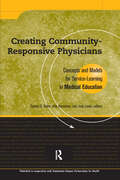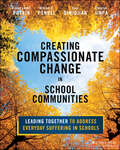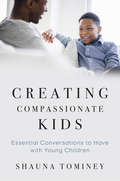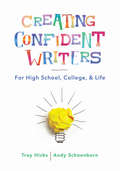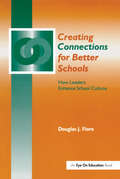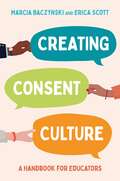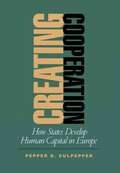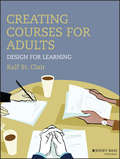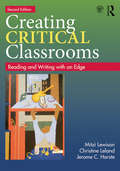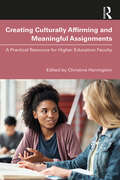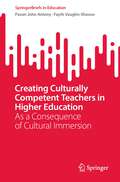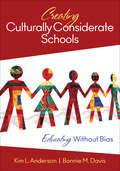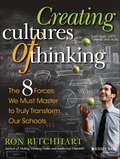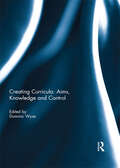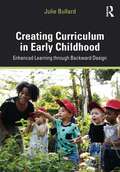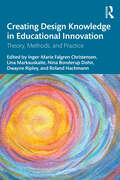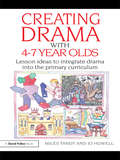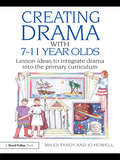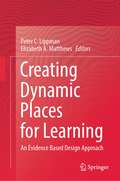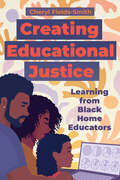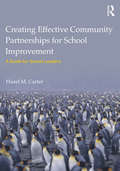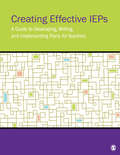- Table View
- List View
Creating Community-Responsive Physicians: Concepts and Models for Service-Learning in Medical Education
by Sarena D. Seifer, Kris Hermanns, Judy Lewis, Edward ZlotkowskiEighth in AAHE’s Service-Learning in the Disciplines Series, this volume shows how service-learning is not only a strategy for preparing community-responsive and competent health physicians, but also for fostering citizenship and changing the relationship between communities and medical schools. This very useful book provides readers with a valuable source of information and inspiration to develop and expand service-learning across the continuum of medical education.
Creating Compassionate Change in School Communities: Leading Together to Address Everyday Suffering in Schools
by Thupten Jinpa Sona Dimidjian William R. Penuel Ashley Seidel PotvinAddressing everyday suffering in schools through compassion Compassion and dignity provide an essential framework for building caring and inclusive schools. Many books focus on what teachers can do as individuals; Creating Compassionate Change in School Communities is different. This book focuses both on how educators can cultivate compassion within themselves and lead together to cultivate humanizing school environments. Teachers, librarians, counselors, resource specialists, mental health professionals, and social workers who are working to create conditions for compassion and dignity in schools are all leaders who can impact change. Offering concrete evidence and case studies that showcase the power of compassion to create flourishing school communities and rejuvenate education, the book will help all educators better serve K-12 students with school cultures that promote healing. Compassion can be cultivated, dignity can be affirmed, and leaders need skillful means to do so—tools and practices that can help them develop compassion for themselves and others and see their own dignity and that of others. Experiment and engage in meditation practices to strengthen personal capacity for mindfulness and compassion and the application to the classroom and school communities Engage in hands-on writing exercises and self-reflection questions educators can ask themselves and then apply their personal growth to influence school policies and climate Gain perspective on compassion in schools through a multidisciplinary lens drawing from contemplative practices, psychology, and organizational change theory Learn from stories and examples of K-12 educators who have exemplified compassion in action While we cannot fully address all the suffering that is happening in schools today, educators do have the power to work within themselves and together locally to create more compassionate responses to suffering and to affirm the dignity of all members of their school communities. Creating Compassionate Change in School Communities offers a valuable approach to integrating wellness into schools, as much for principals and superintendents as for teacher leaders, librarians, counselors, resource specialists, and others who work to create the conditions for compassion and dignity in their school.
Creating Compassionate Kids: 50 Essential Conversations To Have With Young Children
by Shauna TomineyYoung children can surprise us with tough questions. Tominey’s essential guide teaches us how to answer them and foster compassion along the way. If you had to choose one word to describe the world you want children to grow up in, what would it be? Safe? Understanding? Resilient? Compassionate? As parents and caregivers of young children, we know what we want for our children, but not always how to get there. Many children today are stressed by academic demands, anxious about relationships at school, confused by messages they hear in the media, and overwhelmed by challenges at home. Young children look to the adults in their lives for everything. Sometimes we’re prepared... sometimes we’re not. In this book, Shauna Tominey guides parents and caregivers through how to have conversations with young children about a range of topics-from what makes us who we are (e.g., race, gender) to tackling challenges (e.g., peer pressure, divorce, stress) to showing compassion (e.g., making friends, recognizing privilege, being a helper). Talking through these topics in an age-appropriate manner—rather than telling children they are too young to understand—helps children recognize how they feel and how they fit in with the world around them. This book provides sample conversations, discussion prompts, storybook recommendations, and family activities. Dr. Tominey's research-based strategies and practical advice creates dialogues that teach self-esteem, resilience, and empathy: the building blocks for a more compassionate world.
Creating Confident Writers: For High School, College, And Life
by Troy Hicks Andy SchoenbornWriting should be for an audience other than a teacher, and for a purpose beyond getting a grade. Connecting their classroom experience to research about writing, as well as to framing documents in the field, two seasoned writing teachers distill the lessons they’ve learned about creating confident adolescent and young adult writers. Troy Hicks and Andy Schoenborn outline a fundamental stance to their approach—to invite, encourage, and celebrate students’ writing—that is then echoed in the book’s three-part structure. There are numerous classroom activities and assignments on topics from creating writing goals to supporting revision, examples of student work, and questions to guide teachers’ reflections. In this book for any teacher of writing, from middle school through college, readers are invited to try strategies and allow students’ voices to emerge, while discussing with colleagues how these approaches might work for them, too.
Creating Connections for Better Schools: How Leaders Enhance School Culture
by Douglas FioreThis book demonstrates that student achievement depends on school culture, the one element of your school at the foundation of everything that happens there. School culture is the system of beliefs, values, and expectations that governs the feelings and actions of everybody there. This book shows how principals can build relationships and connections to enhance school culture. Practical and accessible, this book provides guidelines which will show you how to:- communicate with teachers, students, and parents on a regular basis - be "visible" - recognize, utilize and empower your faculty
Creating Consent Culture: A Handbook for Educators
by Marcia Baczynski Erica ScottCan you imagine a world where no one feared a violation of their boundaries? A world where everyone felt safe in their bodies and confident in asking for what they wanted? Teaching consent education is the way to achieve this vision, and this entry level book for educators helps you teach and discuss consent issues to young adults, from 10+.The fun, interactive exercises in this book focus on consent in all interactions, not just sexual ones, and explores skills that help young people to increase their relational intelligence and build positive, reciprocal relationships.Drawing on their combined experiences of over 25 years as consent educators, the authors have seen that more respectful, generous and joyful ways of relating to one another are possible. In this vital book, they challenge common assumptions about consent and coercion, and invite educators of all walks to become instigators of a profound culture shift.
Creating Content With Your Tablet
by Susan J. Brooks-YoungTransform students from content consumers to content creators! This comprehensive guide gets to the heart of effective mobile technology use in today’s classroom. Internationally recognized education expert Susan Brooks-Young provides manageable, research-based strategies to help teachers and administrators: Confidently plan and manage mobile technology activities across grade levels Explore new uses and applications for multiple devices Use rubrics and checklists to evaluate appropriate, cross-platform educational apps Manage content-specific tablet use in learning centers or small groups Tap student ingenuity and improve critical thinking skills Time-saving tips cover a wide range of apps to help busy teachers easily incorporate tablets into daily classroom use. Includes step-by-step instructions across content areas for digital photography, video, ePublishing, QR codes and more. Transform students from content consumers to content creators with this must-have resource! "Creating Content With Your Tablet provides educators with simple, easy steps to implement tablet technology with the Common Core Standards. I am encouraged to try the apps in this book. It makes the connection between modern technology and what teachers are already doing in the classroom seem seamless." —Michelle Strom, Language Arts Teacher Fort Riley Middle School, KS "Very practical. The discussion questions at the end of each chapter are excellent for a book study or district that is moving towards tablet implementation." —David Fife, Vice Principal Tweedsmuir Public School, London, Ontario, Canada
Creating Content With Your Tablet
by Susan J. Brooks-YoungTransform students from content consumers to content creators! This comprehensive guide gets to the heart of effective mobile technology use in today’s classroom. Internationally recognized education expert Susan Brooks-Young provides manageable, research-based strategies to help teachers and administrators: Confidently plan and manage mobile technology activities across grade levels Explore new uses and applications for multiple devices Use rubrics and checklists to evaluate appropriate, cross-platform educational apps Manage content-specific tablet use in learning centers or small groups Tap student ingenuity and improve critical thinking skills Time-saving tips cover a wide range of apps to help busy teachers easily incorporate tablets into daily classroom use. Includes step-by-step instructions across content areas for digital photography, video, ePublishing, QR codes and more. Transform students from content consumers to content creators with this must-have resource! "Creating Content With Your Tablet provides educators with simple, easy steps to implement tablet technology with the Common Core Standards. I am encouraged to try the apps in this book. It makes the connection between modern technology and what teachers are already doing in the classroom seem seamless." —Michelle Strom, Language Arts Teacher Fort Riley Middle School, KS "Very practical. The discussion questions at the end of each chapter are excellent for a book study or district that is moving towards tablet implementation." —David Fife, Vice Principal Tweedsmuir Public School, London, Ontario, Canada
Creating Cooperation: How States Develop Human Capital in Europe (Cornell Studies in Political Economy)
by Pepper D. CulpepperIn Creating Cooperation, Pepper D. Culpepper explains the successes and failures of human capital reforms adopted by the French and German governments in the 1990s. Employers and employees both stand to gain from corporate investment in worker skills, but uncertainty and mutual distrust among companies doom many policy initiatives to failure. Higher skills benefit society as a whole, so national governments want to foster them. However, business firms often will not invest in training that makes their workers more attractive to other employers, even though they would prefer having better-skilled workers. <p><p>Culpepper sees in European training programs a challenge typical of contemporary problems of public policy: success increasingly depends on the ability of governments to convince private actors to cooperate with each other. In the United States as in Europe, he argues, policy-makers can achieve this goal only by incorporating the insights of private information into public policy. Culpepper demonstrates that the lessons of decentralized cooperation extend to industrial and environmental policies. In the final chapter, he examines regional innovation programs in the United Kingdom and the clean-up of the Chesapeake Bay in the United States―a domestic problem that required the coordination of disparate agencies and stakeholders.
Creating Courses for Adults
by Ralf St. ClairBecome an effective adult educator by approaching teaching systematicallyAs the author describes at the beginning of Creating Courses for Adults, "The big idea of this book is that education for adults has to be designed." Whether in basic skills training, English language classes, professional development workshops, personal interest courses, or formal degree programs, good teaching tends to conceal all the planning and decisions which had to be made in order to present participants with a seamless and coherent process for learning. The author posits that nobody is a completely intuitive teacher and that everybody has to make a series of choices as they put courses together. The decisions they make are important and far-reaching, and deserve to be considered carefully.Starting with the three core factors which must be taken into account when creating courses, Creating Courses for Adults walks readers through a manageable process for addressing the key decisions which must be made in order to design effective learning.Instructor factors are what the teacher brings to the teaching and learning process, such as experience and preferences.Learner factors are the influences that students bring with them, including their past experiences and expectations for the class.Context factors include the educational setting, whether in-person or online, as well as the subject matter.Readers of Creating Courses for Adults will learn a systematic approach to lesson and course design based on research into the ways adults learn and the best ways to reach them, along with pointers and tips for teaching adults in any setting.
Creating Critical Classrooms: Reading and Writing with an Edge
by Jerome C. Harste Christine Leland Mitzi LewisonThis popular text articulates a powerful theory of critical literacy—in all its complexity. Critical literacy practices encourage students to use language to question the everyday world, interrogate the relationship between language and power, analyze popular culture and media, understand how power relationships are socially constructed, and consider actions that can be taken to promote social justice. By providing both a model for critical literacy instruction and many examples of how critical practices can be enacted in daily school life in elementary and middle school classrooms, Creating Critical Classrooms meets a huge need for a practical, theoretically based text on this topic. Pedagogical features in each chapter • Teacher-researcher Vignette • Theories that Inform Practice • Critical Literacy Chart • Thought Piece • Invitations for Disruption • Lingering Questions New in the Second Edition • End-of-chapter "Voices from the Field" • More upper elementary-grade examples • New text sets drawn from "Classroom Resources" • Streamlined, restructured, revised, and updated throughout • Expanded Companion Website now includes annotated Classroom Resources; Text Sets; Resources by Chapter; Invitations for Students; Literacy Strategies; Additional Resources
Creating Culturally Affirming and Meaningful Assignments: A Practical Resource for Higher Education Faculty
by Christine HarringtonCreating Culturally Affirming and Meaningful Assignments offers principles, strategies, and examples to aid in the development of inclusive college coursework in which all students feel seen and valued. This resource prepares instructors to proactively consider ways to honor and engage with students’ varied identities and lived experiences through assignments. Chapters cover the course design process, methods on getting to know your students, assignment options beyond the exam, and more. Reflection questions at the end of each chapter serve as a springboard for faculty and leadership conversations on equitable and inclusive teaching practices, while the appendix features 20 example assignments sourced from various higher education disciplines. An accessible, practical read, this guidebook is for any higher education instructor who wants to reimagine their assignments to center and celebrate students’ varied cultural backgrounds and experiences.
Creating Culturally Competent Teachers in Higher Education: As a Consequence of Cultural Immersion (SpringerBriefs in Education)
by Pavan John Antony Fayth Vaughn-ShavuoThis book presents evidence of a longitudinal study in teacher preparation utilizing a threefold multicultural (TFM) model of immersion. It establishes the need for culturally responsive teachers in classrooms, and outlines a proven model that can be employed to prepare them.Through the TFM model elements, pre-service teacher candidates participated in class-based, cohort fieldwork experience, and reflective journal writings and discussions. Evidence was gathered from pre- and post-questionnaires, interviews, classroom discussions, and journal writings, along with the inclusion of student voices. Pre-service teacher attitudes, beliefs, and degree of cultural responsiveness changed post-study, and candidates became more effective in the classroom, highlighting the effectiveness of the TFM model.This book is an invaluable resource for universities, under- and postgraduate students, and teachers across the globe as it provides a teacher preparation fieldwork model that helps to prepare culturally responsive teachers for children in any classroom.
Creating Culturally Considerate Schools: Educating Without Bias
by Kim L. Anderson Bonnie M. DavisAre you seeing your students clearly? This unique collaboration between a veteran educator and a psychotherapist asserts that the educators who are most effective in teaching diverse populations are those who can "see students clearly and respond to their needs without hesitation or bias." Framed around an original, eight-stage model of diversity development, this book provides readers with essential tools for building a sturdy foundation of mutual respect. Included are specific strategies for creating a school environment that: Gives voice and consideration to all students Shows interest, empathy, and respect for all staff members Advocates respect and reverence of individuality
Creating Cultures of Thinking
by Ron RitchhartDiscover why and how schools must become places where thinking is valued, visible, and actively promoted As educators, parents, and citizens, we must settle for nothing less than environments that bring out the best in people, take learning to the next level, allow for great discoveries, and propel both the individual and the group forward into a lifetime of learning. This is something all teachers want and all students deserve. In Creating Cultures of Thinking: The 8 Forces We Must Master to Truly Transform Our Schools, Ron Ritchhart, author of Making Thinking Visible, explains how creating a culture of thinking is more important to learning than any particular curriculum and he outlines how any school or teacher can accomplish this by leveraging 8 cultural forces: expectations, language, time, modeling, opportunities, routines, interactions, and environment. With the techniques and rich classroom vignettes throughout this book, Ritchhart shows that creating a culture of thinking is not about just adhering to a particular set of practices or a general expectation that people should be involved in thinking. A culture of thinking produces the feelings, energy, and even joy that can propel learning forward and motivate us to do what at times can be hard and challenging mental work.
Creating Curricula: Aims, Knowledge and Control
by Dominic WyseKnowledge has been a defining focus for the curriculum studies field. In the early part of the 21st century convincing arguments were mounted that knowledge needed to be ‘brought back in’, both to the curriculum of schools and to the attention of curriculum researchers. This book is a result of these arguments, and what some regarded as a ‘crisis’ in curriculum study related to the growing emphasis on international comparisons between education systems. The book’s most important contribution is to build on seminal work in the sociology and philosophy of education in order to develop new foundations for curriculum study, using the importance of ‘transactions’ as the context for understanding knowledge in the curriculum. The contributors build on this importance to suggest a rapprochement in the field around the idea of curriculum knowledge as both constructed and real. This book was originally published as a special issue of The Curriculum Journal.
Creating Curriculum in Early Childhood: Enhanced Learning through Backward Design
by Julie BullardCreating Curriculum in Early Childhood explores the backward design model of curriculum development, equipping readers with the tools and methods they need to effectively apply backward design in the early childhood classroom. Clear yet comprehensive chapters walk new and veteran educators through an effective method for curriculum design that promotes meeting standards through intentional teaching while engaging children in developmentally appropriate, interest-based education focused on big ideas and conceptual understanding. Featuring desired results, assessment methods, and teaching techniques specific to birth to age eight, this critical guide also includes practical tips for educators new to the method. Designed to help students and practitioners alike, this powerful textbook combines early childhood philosophy and developmental research with highly practical descriptions, rationales, and examples for developing curricular units using backward design.
Creating Design Knowledge in Educational Innovation: Theory, Methods, and Practice
by Lina Markauskaite Nina Bonderup Dohn Dwayne Ripley Roland Hachmann Christensen, Inger-Marie FalgrenExamining how research-informed design knowledge is created, represented, and used in educational research and innovation projects, this book offers theoretical, methodological, and practical guidance on how to (and how not to) create, represent, and (re)use research-informed design principles.The chapters explore how educational researchers, designers, teachers, and other innovating practitioners can make outcomes of educational research and innovation projects scalable, readily applicable in educational design, and impactful on practice. They offer methodological "know-how" that is theoretically robust and grounded in research and design experiences. Providing critical reflection on current theories, methods, and practices, this book also considers directions for the future in light of developments in semantic web technologies, AI, and other emerging technologies.This book is a helpful guide for researchers, research students, and innovation designers who aim to produce and apply design knowledge that is robust, grounded in research, and practically useful as a part of diverse research and innovation projects.
Creating Drama with 4-7 Year Olds: Lesson Ideas to Integrate Drama into the Primary Curriculum
by Miles Tandy Jo HowellThis practical book gives you all the ideas you need to make drama a regular and integral part of your school’s curriculum, offering detailed suggestions of drama work for ages four to seven. The teaching units are arranged around four strands: drama for literacy; drama and the whole curriculum; drama film, media, and ICT; and drama for performance. The authors provide a wealth of practical activities throughout. Each unit includes: explicit links to the Renewed Framework for literacy and the wider curriculum a list of resources needed clear learning objectives and outcomes steps for teaching and learning including how to modify activities to suit your school links to writing assessment guidance. Based on the authors’ experience as teachers and in-service trainers, this book provides a Wide range of ideas and activities for inspiring drama across the Foundation Stage and Key Stage 1, and is essential reading for all those interested in bringing drama into their school.
Creating Drama with 7-11 Year Olds: Lesson Ideas to Integrate Drama into the Primary Curriculum
by Miles Tandy Jo HowellThis practical book gives you all the ideas you need to make drama a regular and integral part of your school’s curriculum, offering detailed suggestions of drama work for ages 7 to 11. The teaching units are arranged around four strands: drama for literacy; drama and the whole curriculum; drama film, media, and ICT; and drama for performance. The authors provide a wealth of practical activities throughout. Each unit includes: explicit links to the Renewed Framework for literacy and the wider curriculum a list of resources needed clear learning objectives and outcomes steps for teaching and learning including how to modify activities to suit your school links to writing assessment guidance. Based on the authors’ experience as teachers and in-service trainers, this book provides a wide range of ideas and activities for inspiring drama across Key Stage 2, and is essential reading for all those interested in bringing drama into their school.
Creating Dynamic Places for Learning: An Evidence Based Design Approach
by Peter C. Lippman Elizabeth A. MatthewsThis book showcases how an evidence-based design approach can be utilized in the planning of learning environments, by acknowledging the interconnectedness of research, practice, and theory as core considerations in the design of learning environments. Toward this end, this volume explores a multi-disciplinary perspective that draws upon modern learning theories, and empirical research from the fields of environmental psychology education, and architectural practice. By presenting this information in an accessible manner, it enables researchers, educators and designers to take actionable steps needed to re-imagine their settings and create dynamic places for learning.
Creating Educational Justice: Learning from Black Home Educators
by Cheryl Fields-SmithA thoughtful, research-based discussion of Black homeschool experiences as models for educational improvement in K–12 public education
Creating Effective Community Partnerships for School Improvement: A Guide for School Leaders
by Hazel M. CarterCreating Effective Partnerships for School Improvement places the school within the community which is composed of a number of key players, including school leaders, classroom teachers, private foundations, higher education institutions, business and community based organizations, and government agencies. This book encourages leaders to embrace this broader community of stakeholders and to focus on the often overlooked and underutilized college and university partnerships. Grounded in case study analysis of innovative programs and practices, this book explores research-based strategies for educational leaders to implement in order to develop and sustain effective partnerships. Creating Effective Partnerships for School Improvement is an important text for aspiring and practicing administrators interested in creating effective partnerships for school improvement. Special Features: Reflective exercises and portfolio building activities help aspiring and practicing leaders make on-the-ground connections. Learning objectives, key terms, and additional resources further engage readers with the chapter content. Extensive appendices with sample activities, evaluation plans, meeting agendas, promotional materials, and budgets provide additional support to leaders. Alignment to the Educational Leadership Constituent Council (ELCC) Standards.
Creating Effective IEPs: A Guide to Developing, Writing, and Implementing Plans for Teachers
by Nancy BurtonCreating Effective IEPs: A Guide to Developing, Writing, and Implementing Plans for Teachers is a brief primer on Individualized Education Plans that has been developed as a custom supplement for textbooks in Introduction to Education, Introduction to Inclusion, and SPED Teaching Strategies. The Individualized Education Plan is one of the most important parts of an exceptional child’s education – it is the document shared among teachers, administrators, paraprofessionals and parents that outlines the accommodations and strategies for educating a child with special needs. An effective IEP must be well-thought out, clearly defined, and embraced by all parties involved in a child’s education, including administrators and parents. This primer provides practical instruction for writing IEPs, leading IEP meetings, and implementing the goals in a classroom setting. Practical exercises and real-world appendices help make the material accessible for students preparing to enter the workforce.
Creating Effective IEPs: A Guide to Developing, Writing, and Implementing Plans for Teachers
by Nancy BurtonCreating Effective IEPs: A Guide to Developing, Writing, and Implementing Plans for Teachers is a brief primer on Individualized Education Plans that has been developed as a custom supplement for textbooks in Introduction to Education, Introduction to Inclusion, and SPED Teaching Strategies. The Individualized Education Plan is one of the most important parts of an exceptional child’s education – it is the document shared among teachers, administrators, paraprofessionals and parents that outlines the accommodations and strategies for educating a child with special needs. An effective IEP must be well-thought out, clearly defined, and embraced by all parties involved in a child’s education, including administrators and parents. This primer provides practical instruction for writing IEPs, leading IEP meetings, and implementing the goals in a classroom setting. Practical exercises and real-world appendices help make the material accessible for students preparing to enter the workforce.
